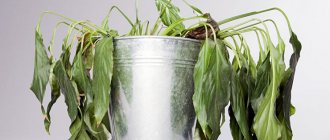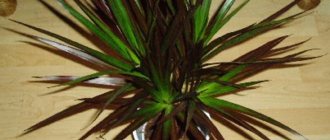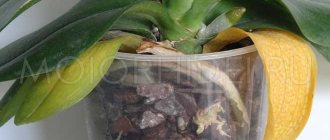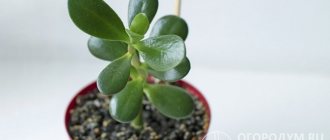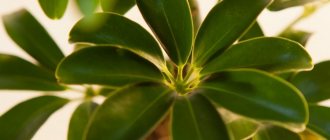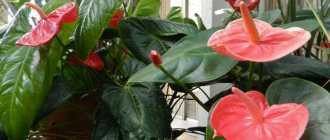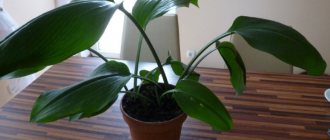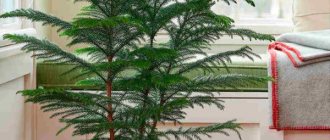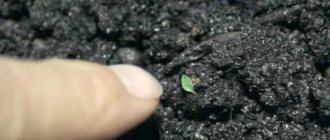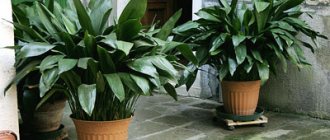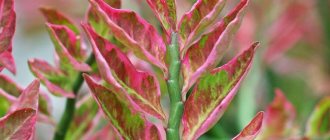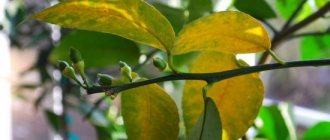Dracaena is a southern plant and proper care at home and maintaining the desired microclimate are extremely important. The main problem with the plant is yellowing and falling leaves. Of course, if the lower leaves are slightly dry, then there is no need to panic. Over time they will fall off, but form lush tufts at the tops. If the flower turns yellow, it must be saved from the disease.
The plant’s homeland is the tropics, so dracaena, although a fairly hardy plant, reacts painfully to sudden changes in temperature, frequent watering, low indoor humidity and can develop certain diseases. If treatment is not carried out on time, the flower can quickly die and infect the seedlings in nearby flowerpots.
Why do dracaena leaves turn yellow and fall off?
There are several reasons why dracaena leaves turn yellow and dry. The natural cause of yellowing is the age of the plant; dracaena leaves live for about two years, and then, starting from the tips, turn yellow. If the leaves of a young plant turn yellow or dry, you need to look for the reason.
Improper watering
The basic rule for watering a plant is not to overwater ; the soil should dry out between waterings. In summer, the plant is watered two to four times a week, in winter - no more than twice. In summer, the top layer of soil should dry well; in winter, it should be completely dry; check with a thin stick.
From excess moisture, the root system begins to rot, and the dracaena turns yellow and dries.
When watering, it is advisable to use settled water, and then loosen the soil to supply oxygen to the roots.
Failure to comply with temperature and humidity standards
Many flowerpot lovers make a mistake when choosing a place for dracaena. Despite the fact that the guest comes from hot Africa, dry air is contraindicated for her. Under no circumstances should a pot with a plant be placed next to heating appliances.
This is precisely the root cause why dracaena turns yellow and falls off.
Suitable temperature for dracaena is from 18 to 25 degrees
. At low temperatures she may get sick. Dracaena loves soft, diffused light; in winter it needs additional lighting.
The humidity in the room where the plant is located must be maintained at a sufficient level. To do this, you can use spraying or a warm shower with room water.
A shower, in addition to freshness, will wash away the dust from the leaves, but before you put the plant back in place after a shower, make sure that there is no water left in the axils between the leaves - the dracaena turns yellow for this reason.
Insufficient plant nutrition
During the growth period, the plant needs nitrogen.
Flower shops have compositions suitable for deciduous flowerpots with a high content of this element. Add the drug to the water when watering from March to August.
During the growth period, the complex composition has a good effect on the plant: ammonium sulfate (0.3 g), potassium nitrate (0.5 g), potassium phosphate (0.4 g).
The ingredients are mixed and diluted with a liter of water. This solution is most effective when sprayed.
fertilizers in the form of sticks in stores ; one such stick is enough for a long period. It needs to be stuck vertically into the soil and forget about fertilizing for a while.
For lush growth of the plant’s green mass, use a solution of nitroammophoska or organic infusions every fourteen days. Fertilizing to prevent darkening of leaf tips
– preparations “Master” or “Stimul”, they are administered once every fourteen days.
In winter, when the room temperature is 16-20 degrees, fertilizing is reduced to once a month. In this case, only the soil is fertilized; foliar feeding is not used.
Why do spots appear on leaves?
Spots on the leaves of a plant may indicate improper care or infection with diseases.
Exposure to direct sunlight
Yellow spots on dracaena are sunburn; it appears if your plant is in direct sunlight.
When placing a flowerpot on a balcony or loggia in the warm season, do not forget to shade it.
Signs of too bright light are pale leaf color and drying of the tips of the leaf blade. In the summer, dracaena often needs to be removed from hot places; overheating also affects the general condition of the plant.
Affected by diseases
Dracaena is susceptible to diseases and pests. Bacterial rot affects the leaves, and high humidity and frequent watering contribute to the spread of the disease.
You need to know how to save dracaena if the leaves turn yellow and dry out due to disease. First of all, for prevention, add phosphorus and potassium when fertilizing.
Reducing watering and treating with insecticides will help fight diseases.
If you suspect an attack by parasites (thrips, spider mites or scale insects), remove the dracaena from other flowerpots to avoid infection. The following products will help fight pests: Iskra, Promonal and Actellik.
The location of the dracaena in a draft
Brown spots indicate freezing of the dracaena.
The plant does not like temperature changes and drafts. It is not recommended to place the flowerpot on a windowsill with a window that opens for ventilation. Fresh air is good, but a sudden change in temperature will cause the tips of the leaves to become covered with brown spots.
Make sure that the windows have good seals; often even modern plastic bags allow cold air to pass through in strong winds. Frozen leaves can be saved by washing with warm water.
Is it easy to treat dracaena at home?
Dracaena is an exotic but unpretentious plant. With proper care it will become a real decoration in the corner of a room or office. The shaggy tops are attractive, and in appearance, due to the shape of the crown and leaves, the plant is very similar to a dragon.
The flower tolerates shade and does not require special care skills. However, a luxurious and fluffy dracaena will delight the eye only when all the rules of care and cultivation at home are followed, and all measures to combat diseases at the initial stage are taken in a timely manner.
Treating dracaena is not difficult if done in a timely manner. It is best to carry out preventive measures to combat diseases and not neglect the conditions of the plant. If yellow spots appear on the leaves, the edges dry out, or the upper part of the root system is damaged, it is better to replant immediately.
Particularly dangerous is the fungus that can reside in the substrate. It is necessary to replace the soil and add charcoal.
The basics of prevention are maintaining temperature, humidity conditions and eliminating drafts. Experienced flower growers advise creating conditions so that the dracaena blooms, smells fragrant and delights the eyes of others for many years with its luxurious beautiful flowers.
Why does dracaena dry out after transplantation?
The plant cannot remain in the same soil for a long time. The best option for good development would be to replant every two to three years. Often the plant begins to dry out after changing the pot, this indicates that the procedure was performed incorrectly, perhaps the wrong soil was selected or the root system was damaged.
Let's figure out how to properly perform the process of transplanting a plant.
In order not to damage the roots of the dracaena,
it is replanted using a transshipment method .
It is better to choose the soil for palm plants, it is good to add sand and charcoal. Remember, the soil for dracaena should be light, loose and not acidic. About two weeks after transplantation, dracaena adapts to new conditions, and the leaves may turn yellow. To help the plant recover, spray the new soil with Epin or colloidal iron.
Quite often, dracaena is grown in water, but when left in an aquatic environment for a long time, the dracaena’s trunk turns yellow.
Mineral substances are deposited on the walls of the container, which interfere with the proper development of the plant; in addition, the aquatic environment is favorable for the development of bacteria.
Transplant the dracaena into the soil; attention and care will help it recover.
Many pet owners are wondering about the toxicity of dracaena. It has been noticed that cats simply love to chew the leaves of the plant. There is no need to worry about this - there is no harm to either animals or people.
A plant that resembles a palm tree will become another exotic decoration for your home.
Among indoor plants, dracaena, which is sometimes called the “false palm,” is very popular among gardeners.
The deep, rich color of its leaves and the splendor of the crown attracts attention.
However, if the plant begins to “fall of leaves”, then everything is for real, without “false modesty” - all that is left of its former beauty in a matter of days may be just one bare stem.
To prevent this from happening (although the reasons can sometimes be objective and cannot be avoided), you need to carefully monitor the condition of your green pet and, if you feel something is wrong, take action.
Pests
Why Dieffenbachia leaves turn yellow - reasons
Failure to follow the rules of care leads to parasites attacking the dracaena. Sucking the juices from the leaves leads to the slow death of the flower.
Pests can destroy a flower overnight
Dracaena pests:
- thrips. This is the most dangerous parasite that attacks indoor plants. Its length is only 1.5 mm. Pests, settling on the foliage from below, begin to actively suck out the cell sap. The females gnaw through the tissue, causing the leaf blade to turn yellow. As a result, the foliage dries out and falls off. High room temperature leads to their rapid reproduction. To save the flower, dracaena leaves are sprayed with a soap solution and covered with a plastic bag. A sticky trap also reduces the number of pests. In addition, drugs such as spark, fitoverm help;
- Mealybugs. This insect can be seen with the naked eye. On top it is covered with a white waxy coating. Females and larvae suck the juice from the cells, disrupting the development of the flower. Moving quickly, they leave behind a whitish coating. Using a toothbrush dipped in soapy water, you can remove waxy traces of parasites. Akhtar, fitoverm or calypso will help save dracaena in case of severe damage;
- scale insect A common parasite among indoor plants. This arachnid is covered on top with a protective shield. The female lays a huge number of larvae, which, like adults, are covered with scutes. They are securely attached to the foliage and suck the juice from it. Dracaena stops developing, turns yellow, dries out and dies. Treatment is carried out using a sponge and methyl alcohol (very carefully). Once weakened, the pests are destroyed with drugs such as Inta-SM or Actara. Yellow leaves of the plant must be removed.
Important! After treating the plant with chemicals, it is necessary to replace the top layer of the substrate.
Problems with dracaena
The main problems of dracaena, like most crops whose homeland is the tropics, are related to acclimatization. In an ordinary city apartment, the plant often lacks heat and humidity . Both the dracaena and the other need to be given additionally, and this must be done competently, without going to extremes.
If you find that the dracaena has a soft trunk and the leaves are falling off, the bark has become wrinkled, then you have gone too far with watering.
If the leaves begin to curl or turn into a tube (this may mean that the plant has died), it means that you were unable to provide your green pet with a comfortable temperature and did not protect it from sudden transitions from one microclimate to another.
Diseases and pests also create problems for the flower, which you need to learn to recognize in a timely manner.
The leaves are falling
Of all the varieties, the threat of “baldness” most often occurs in Marginata; in other varieties this problem is less noticeable. The main reasons why dracaena leaves fall may be the following:
- natural aging (the leaves of this crop live from 2 to 3 years);
- water scarcity;
- cold air, drafts.
To help the plant, it is important to figure out which reason is destroying your flower.
If the issue is aging, then this is an objective and unregulated process. Fortunately, nature has provided that all the leaves of the dracaena will not leave at the same time - those of them whose time has come will begin to turn yellow, then curl, turn black and fall off. After some time, new, healthy leaves will appear in the vacated places.
In case of water shortage, mass leaf fall also does not occur.
The difference is that aged leaves dry out completely, while those that have fallen due to scarcity of watering still partially retain their vitality .
If the grower overdos it with watering, the plant begins to lose green leaves - this is due to the fact that the roots rot in the waterlogged soil and the plant dies.
Temperature discomfort (especially cold, draft) is expressed in the loss of green foliage by the plant.
Diseases
Why do dracaena leaves fall off - reasons
The cause may be too dry air, too low a temperature or sudden changes in the environment. If you move a dracaena, for example, from a cool street to a warm apartment, this can lead to cracking of the edges of its leaves. In addition, you should not expose the plant to temperature fluctuations. Yellowing of the leaf blade is guaranteed.
One of the symptoms of the disease is yellow leaves
Dracaena diseases can also occur as a result of excessive sun exposure, which leads to burns on the leaves. In turn, too little light can lead to fading and weaker colors found in some varieties. Slowing growth, transparency of leaves, as well as their yellowing and falling off are possible consequences of improper propagation of dracaena.
Most often, the flower is affected by infectious diseases. They are transmitted from neighboring plants and brought in with tools while loosening the soil. If you ignore the yellowing of the foliage and do not take action, the dracaena will soon die.
Important! The infection can be brought into the house with other indoor plants from a store or market, as well as with untreated garden tools.
Bacterial infection
A bacterial infection on dracaena appears as dark brown, rapidly growing spots on the tips of the leaves. Sometimes the stem also turns black at the base and the rot moves to the petioles. The result may be an unpleasant odor. For mild infections, remove diseased leaves and spray the plant and substrate with a growth stimulant, which reduces the development of spot disease. Unfortunately, once the disease is advanced, it is no longer possible to save the plant.
Bacteria attack leaf tips
Fungal infection
May have a bacterial or fungal basis. Yellow, brown, irregular spots ranging in size from 1 to 5 mm with a red border appear on the leaves of dracaena. On top of them are black clusters of fungal spores. It is important to remove the affected leaves and stop spraying the plant. To preserve dracaena, a series of biological products and fungicides should be used.
Fungal disease
Note! To prevent fusarium spotting, you need to take the same preventive measures. With this disease, rotting of the leaf rosettes is observed, and small watery spots with a light yellow border appear on the leaf blades.
Mold in the soil
Mold in the soil damages most houseplants. Its appearance is promoted by poor soil quality, lack of light, high air and soil humidity, and excessive watering. If mold is detected in the spring, it would be advisable to transplant the plant into fresh soil with a loose substrate, preferably with a drainage layer.
This is what mold in the soil looks like
The leaves are turning yellow
If yellowness on the leaves appears, like gray hair in a person, for natural reasons, it may not affect the whole leaf, but its tips. In this case, experts recommend pruning, removing only the yellowed part and leaving the healthy part . This will preserve the decorative nature of the culture.
Often the problem arises because the plant does not have enough sun. For most varieties, soft, diffused light is sufficient, and even a short winter day does not have a negative effect on them. However, in some cases, dracaena cannot do without lighting and communicates this to the owner by the yellowness of its leaves.
A similar reaction occurs due to excessive watering. And if the dracaena leaves droop and turn yellow, this may be caused by a lack of nutrients in the soil. It is especially dangerous to keep a flower on a starvation diet during its active growth - from April to the end of August.
Other Possible Problems
Most often, the leaves of a houseplant turn yellow due to improper watering or excess sunlight. But there are also others that novice gardeners may not be aware of.
Among them:
- cold and drafts have a negative effect on tropical plants. Dracaenas do not like to grow near air conditioning, ventilation holes and open windows, and every movement of air masses is immediately reflected in the appearance of the plants: yellow leaves or pale spots appear between the veins. It is better to place an indoor flower at home in a quiet place;
- transfer. In order for the flower to grow well and have abundant foliage, it must be replanted periodically. If the plant's leaves begin to turn yellow, become spotted, or fall off, it's time to change the pot and soil. Usually, when dracaena grows for more than three years in the same substrate, it grows poorly. The thing is that a huge amount of salts begin to accumulate in the old soil, which prevent the flow of nutrients to the above-ground part. In order for the flower to feel good, it is recommended to replant every two years (in spring). For looseness, add a little sand or charcoal to the soil mixture. In addition, it is necessary to replace the top layer of soil with a new one every year;
- nutritional deficiency. If yellow leaves begin to appear at the top of the plant, this symptom is likely due to nutrients in the soil. This is caused by too much calcium in hard water or too little nitrogen in the soil. This problem can be solved by using nitrogen fertilizers or replacing irrigation water;
- excess nitrogen fertilizers. Irrational use of fertilizers leads to leaves falling off, sometimes they do not even have time to turn yellow.
Dracaena is a beautiful and beloved indoor plant. With proper care, it delights with its abundant bright green foliage. The flower begins to shed its leaves after two years. These are natural processes. Yellowing of the leaf blade also does not always indicate developmental disorders or the presence of diseases. Old foliage on the lower tiers should turn yellow and then fall off. But excessive yellowing, falling off and additional symptoms should alert you. After finding out the cause and working on the errors, the plant will begin to grow with renewed vigor.
The ends are drying out
This trouble can occur even with young foliage if the flower grows in the same pot, without replacing the soil, for 3-4 years.
Salts accumulate in it, due to which the plant is not able to fully absorb nutrients, even if the owner regularly feeds his pet.
The suction roots, the main conductor of nutrients into the flower’s body, die from salinity.
Due to poor nutrition, the tips of old leaves also dry out. In addition, the problem may lie in the structure of the soil - if it is clayey, heavy, and poorly permeable to water.
Yellow, brown, black spots on dracaena
Never reassure yourself with the phrase that “even the sun has spots”: spots on dracaena leaves pose a threat to the health of the flower and most often appear due to insufficient care for the plant, and their color helps determine the essence of the problem. Here's what they're talking about:
- yellow - that the plant has received a sunburn and it can no longer be on the windowsill or loggia under direct rays directed at it;
- brown - the plant has suffered due to cold or sudden temperature changes; it is possible that it is exposed to a draft when the windows are opened for ventilation;
- brown with a light center means that the dracaena suffers from Alternaria;
- light brown spots with a yellow-green edging, turning after some time into black, indicate phyllocystic disease;
- elongated brown spots with a red edge indicate that the plant suffers from heterosporiosis.
Soil moisture
Why do geranium leaves turn yellow at home - causes and treatment
Dracaena is a plant that came to Russia from countries where drought alternates with heavy rains. This led to the fact that the plant acquired special properties that make the flower resistant to irregular watering. However, these changes that nature gave to the flower become a huge disadvantage when the plant is in a constantly humid environment.
Proper watering will be a good preventative against yellowing of foliage.
The best way to water this plant is by immersion method:
- Partially fill a sink or large container with water.
- Place the pot. The water should reach the level of the soil in the pot.
- Soak the pot of dracaena in water for 7-10 minutes.
- Lift the pot and place it on a wire rack to allow any excess water to drain.
- When the dripping has stopped, return the plant to its place.
You can water the next time only when the soil is completely dry. To check, you should deepen your finger 5-8 cm. It should be dusty and dry. If there is even a little moisture left, there is no need to water. It is important to periodically loosen the substrate. This will saturate it with oxygen and become a good preventative against diseases.
Note! Experienced gardeners assure that dracaena needs to be watered every 5-7 days.
In winter, dracaena is dormant. At this time, the same rules as above apply, except that it may take up to a month for the soil to dry out from the previous watering. You can water every 15-30 days. There is no need to moisten the soil weekly.
Correcting errors in care
If the trunk of the dracaena has shriveled and the leaves have begun to fall, there is a high probability of mistakes that the owner made, most likely due to inexperience. The main thing is to have time to correct them in time.
Among the most common mistakes:
Dracaena diseases, symptoms, treatment
Experts (in order to prevent various diseases) recommend adding potassium and phosphorus to fertilizers . Unfortunately, this is not enough to avoid illness completely.
Dracaena diseases can be:
- heterosporiosis (its manifestations are brown spots on the leaves, olive-colored bloom, treatment is spraying with Fungicide);
Pests and parasites of dracaena. White coating on the trunk
Pests that attack dracaena can be in the soil or get onto it from neighboring, already infected plants. Signs of ill health include cobwebs, spots, and sticky residue. Among the pests:
- spider mite (yellow spots and cobwebs appear on the leaves);
- thrips (their colonies are based on the lower part of the leaves, the upper part is covered with gray-brown dots);
- scale insect (causes “leaf fall”, attacks the stem, covering it with a white coating);
- mealybug (lumps resembling cotton wool appear on the leaves, and a white coating appears on the stem);
This video talks about another dracaena pest and a way to combat it:
Tips - how to save dracaena from death
How to revive dracaena if the trunk is fragile, the bark is wrinkled, and the leaves begin to rot? A “surgical intervention” will be required : cut off the top of the dracaena and either immediately root it in the ground or place it in a container with water so that roots appear. This usually takes 2 months.
If the poor condition of the dracaena is associated with dry air, a warm shower will help . To prevent water from flooding the roots, the pot should be placed in a plastic bag and its edges should be tightened around the trunk.
If the cutting (and subsequently a full-fledged plant) stands in water for too long, its trunk may turn yellow. This happens because the aquatic environment promotes the activation of bacteria, and the changed color of the trunk is evidence that the plant may die. You can avoid this development of events by urgently transplanting the dracaena into a pot of soil.
A plant damaged by cold air can be saved by several sprays with warm water and placing the pot in a place protected from drafts. In cases where the temperature dropped below 15 degrees Celsius, there is a high risk that the roots were damaged. If the check shows that this is what happened and the roots began to rot, they are removed and the dracaena is transplanted into a new pot. In cases where there are practically no healthy roots left, the top of the flower is cut off and rooted. What to do with a broken dracaena
The broken woody part of the stem is quite easy to root. To do this, you need to cut the broken area with a sharp knife (the cut should be horizontal), hold it in the air for a while to dry, and lower it into a container of water, where an activated carbon tablet has been added (it will protect the future plant from rotting).
The part of the stem remaining in the pot can also be saved. The fracture site is carefully trimmed and filled with wax. After a short time, shoots will appear on the sides of the stem.
If it is not the woody shoot that is broken, but the green one, it is recommended to root it in moss or sand. In order for roots to form faster, the tip of the shoot is treated with the preparation “Kornevin”, and then artificial heating is organized (the best temperature is 25 degrees).
- Author: Maria Sukhorukikh
Rate this article:
- 5
- 4
- 3
- 2
- 1
(1 vote, average: 2 out of 5)
Share with your friends!
Root rotting
The fact that the leaves have begun to turn yellow may indicate that the roots have begun to rot due to excess moisture.
Rotted dracaena roots
How to understand that the soil is waterlogged:
- damp, undried soil smells of dampness and mold;
- Having buried your finger 2 cm, you can feel that the soil is damp;
- when using mulch, it signals an excess of moisture by turning black;
- There will be stagnation of water in the container under the pot.
Important! A drainage layer in a pot with dracaena will allow you to control comfortable soil moisture. During replanting, a new layer should be used.
